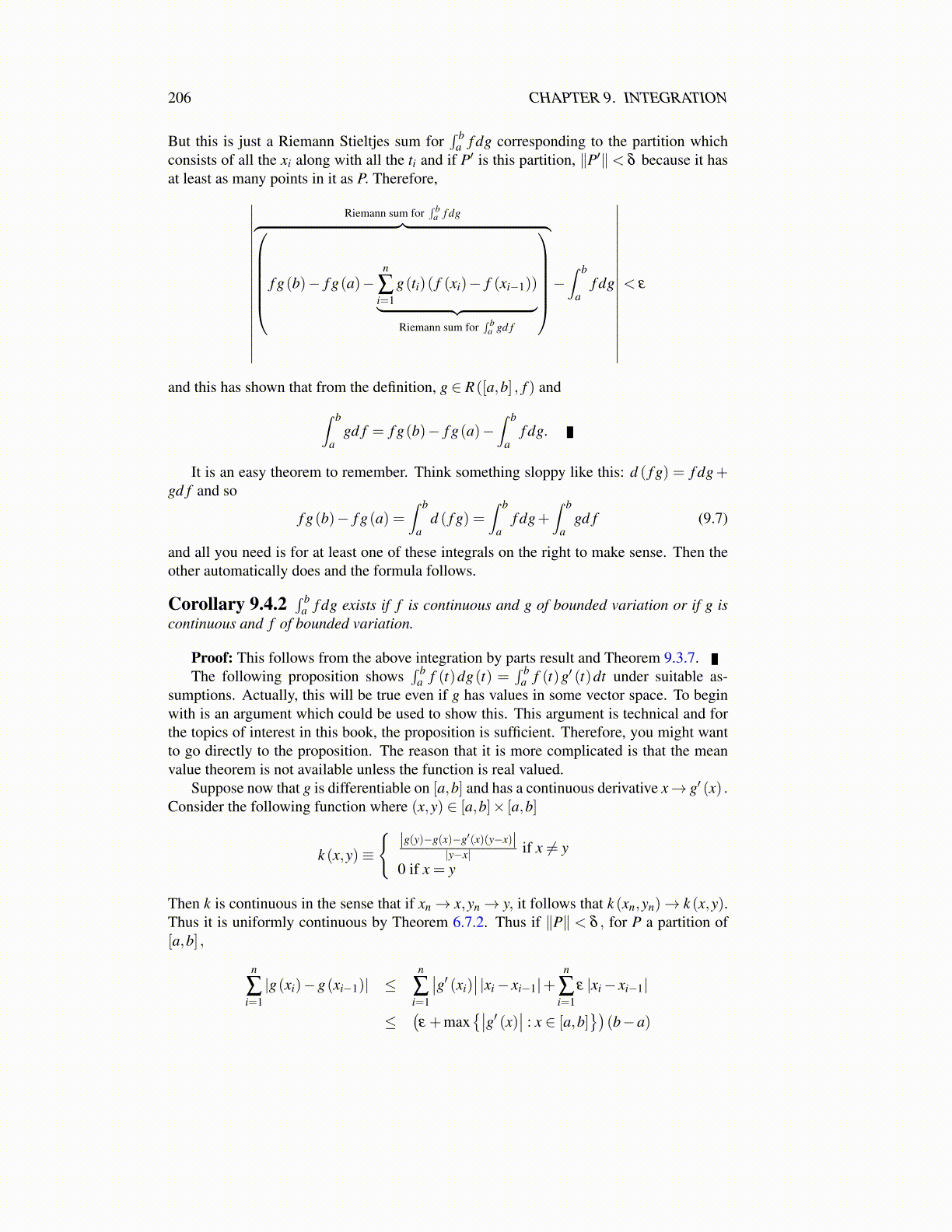
206 CHAPTER 9. INTEGRATION
+
∣∣∣∣∣ n
∑i=1
f (vi)(g(xi)−g(xi−1))−∫ b
af (t)dg(t)
∣∣∣∣∣< ε +0+ ε = 2ε
Since ε is arbitrary, this shows∫ b
a f (t)dg(t) =∫ b
a f (t)g′ (t)dt.What does the integration by parts formula 9.7 say in case g′ exists and is continuous
and f ′ exists and is continuous? By Proposition 9.4.3 above, both∫ b
a f dg and∫ b
a gd f exist.Now the integration by parts formula says f g(b)− f g(a) =
∫ ba f dg+
∫ ba gd f and from
what was just shown in Proposition 9.4.3, this reduces to
f g(b)− f g(a) =∫ b
af (t)g′ (t)dt +
∫ b
ag(t) f ′ (t)dt (9.8)
which is the usual integration by parts formula from calculus.
Proposition 9.4.4 Let f ,g both be continuous on [a,b] with continuous bounded deriv-atives on (a,b) . Then the usual calculus integration by parts formula 9.8 is valid.
9.5 The Fundamental Theorem of CalculusNote how as a special case, you get the usual fundamental theorem of calculus by lettingf (t)≡ 1. Indeed, from Theorem 9.4.1
∫ b
a1g′ (t)dt =
∫ b
a1dg(t)+
obviously 0︷ ︸︸ ︷∫ b
agd f = 1g(b)−1g(a) = g(b)−g(a)
This proves:
Theorem 9.5.1 If g′ is continuous on [a,b] , then g(b)−g(a) =∫ b
a g′ (t)dt.
A version of this presented more directly is the following.
Theorem 9.5.2 Suppose∫ b
a f (t)dt exists and F ′ (t) = f (t) for each t ∈ (a,b) forsome F continuous on [a,b]. Then
∫ ba f (t)dt = F (b)−F (a).
Proof: There exists δ > 0 such that if ∥P∥< δ , then for P = x0, · · · ,xn,∣∣∣∣∣∫ b
af (t)dt−
n
∑k=1
f (tk)(xk− xk−1)
∣∣∣∣∣< ε, for any tk ∈ [xk−1,xk] .
Use the mean value theorem to pick tk ∈ (xk−1,xk) such that f (tk)(xk− xk−1) = F (xk)−F (xk−1) . Then∣∣∣∣∣
∫ b
af (t)dt−
n
∑k=1
f (tk)(xk− xk−1)
∣∣∣∣∣ =
∣∣∣∣∣∫ b
af (t)dt−
n
∑k=1
F (xk)−F (xk−1)
∣∣∣∣∣=
∣∣∣∣∫ b
af (t)dt− (F (b)−F (a))
∣∣∣∣< ε
Since ε > 0 is arbitrary, this proves the theorem.